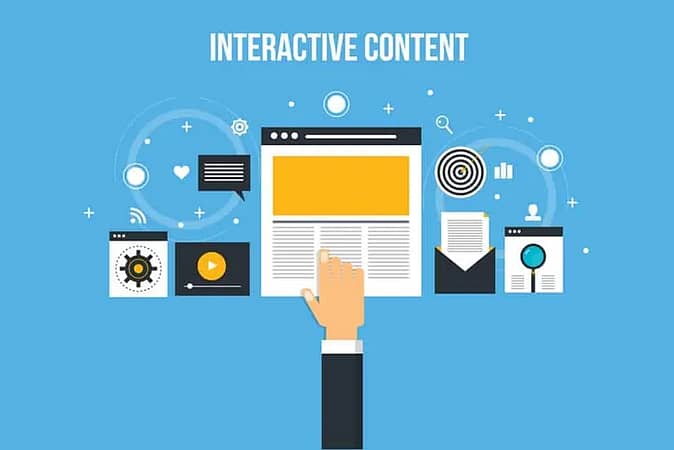What makes interactive content in the future marketing lead?
Introduction
What makes interactive content in the future marketing lead? the answer to this question lies in this blog – The digital landscape is evolving rapidly. Consequently, the way we consume content is also changing. In a world overflowing with information, however, traditional static content is losing its appeal. Instead, a new alternative emerges – enter interactive content.
This dynamic and immersive approach not only captivates audiences but also encourages participation and delivers a personalized experience. In this blog post, we will delve into the reasons that say interactive content in the future marketing leads and examine how it revolutionizes engagement across various platforms.
What is Interactive Content Marketing?
Interactive content marketing refers to the practice of using dynamic and engaging content formats to attract, interact with, and delight audiences. It goes beyond traditional static content by encouraging active participation from users, allowing them to engage, explore, and personalize their experience.
Interactive content marketing encompasses various formats such as quizzes, polls, calculators, assessments, games, interactive videos, and augmented reality (AR) or virtual reality (VR) experiences. It aims to captivate the audience, foster deeper engagement, collect valuable user insights, drive conversions, and amplify social sharing. Additionally, by providing interactive and immersive experiences, brands can forge stronger connections with their target audience. This, in turn, leads to increased brand visibility and creates memorable interactions that resonate with users long after the content is consumed.
The Power of Interactivity: Beyond Passive Consumption
Breaking the Passive Consumption Barrier
Static content, such as blog posts and articles, often requires passive consumption, where readers absorb information without active participation. Conversely, interactive content encourages users to engage actively, sparking curiosity and driving meaningful interactions. Consequently, this shift from passive to active consumption paves the way for a more immersive and memorable experience.
Here’s a similar article that describes this even better – The Power of Interactive Content
Personalization: Empowering the User
Customizing the User Experience
One of the most significant advantages of interactive content is its ability to deliver personalized experiences. Consequently, by leveraging user data, interactive content adapts to the preferences, needs, and interests of each individual, ensuring a tailored experience. From personalized recommendations to interactive product configurators, this level of customization not only strengthens user engagement but also fosters a sense of connection.
Collecting Actionable Insights
Interactive content opens up avenues for collecting valuable user insights. Consequently, by tracking interactions, engagement patterns, and user preferences, brands can gather data-driven insights to refine their marketing strategies, create targeted content, and make informed business decisions. Moreover, the real-time feedback obtained through interactive content helps optimize user experiences and generates actionable data for continuous improvement.
Boosting Conversion Rates and Sales
Interactive Content as a Conversion Catalyst
Interactive content acts as a catalyst for conversion by actively involving users in the sales funnel. Moreover, quizzes, assessments, and interactive product demonstrations enable users to evaluate options and make informed decisions, thereby increasing the likelihood of conversion. Additionally, by delivering value and addressing user needs directly, interactive content builds trust, credibility, and a stronger connection with the audience.
Immersive Experiences Driving Sales
In the age of experience-driven marketing, interactive content plays a pivotal role in driving sales. Furthermore, from virtual reality (VR) experiences to augmented reality (AR) try-ons, interactive content enables users to visualize and experience products in realistic and immersive ways. These interactive experiences effectively bridge the gap between the online and offline worlds. This fosters confidence and ultimately leads to higher conversion rates.
Amplifying Social Sharing and Virality
The Power of Shareability
Interactive content has an inherent shareability factor that amplifies its reach. When users encounter content that offers a unique and engaging experience, they are more likely to share it with their network. This organic sharing increases brand exposure, drives traffic, and boosts overall engagement. Furthermore, interactive elements like quizzes and contests can be designed to encourage social sharing as part of the user experience, creating a ripple effect.
Creating Viral Content Experiences
Interactive content possesses the potential to go viral due to its engaging nature and shareability. Moreover, immersive experiences, interactive challenges, and gamification elements can generate buzz, captivate audiences, and trigger social media trends. Additionally, when interactive content goes viral, it creates a snowball effect, attracting a broader audience and significantly increasing brand visibility.
7 reasons that says Interactive Content in the Future marketing leads
Here are 7 reasons that says Interactive Content in the Future marketing leads:
- Enhanced Engagement: Interactive content encourages active participation, resulting in higher engagement levels and increased brand exposure.
- Personalized Experiences: Interactive content allows for tailored experiences based on individual preferences, needs, and interests.
- Improved Information Retention: Interactive elements create memorable experiences that enhance information retention and understanding.
- Data-driven Insights: Interactive content provides valuable data insights into customer behavior, content performance, and user preferences.
- Increased Conversion Rates: Interactive content actively involves users in the sales funnel, increasing the likelihood of conversions.
- Amplified Social Sharing: Interactive content is highly shareable, leading to increased brand visibility and potential viral reach.
- Adaptability to Various Platforms: Interactive content can be deployed across multiple platforms. This includes websites, social media, and mobile apps, reaching a broader audience.
These reasons highlight the value of interactive content in driving engagement, personalization, retention, conversion, and social sharing. By embracing interactive content marketing, brands can stay ahead in the evolving digital landscape.
Conclusion
The interactive content in the future—a paradigm shift from passive consumption to active engagement. Furthermore, interactive content breaks barriers, enhances engagement and retention, and delivers personalized experiences. Additionally, it empowers users, boosts conversion rates, and amplifies social sharing and virality.
As technology advances and user expectations evolve, embracing interactive content is key for brands and content creators to stay relevant, memorable, and successful in the dynamic digital landscape. By adopting interactive content strategies, businesses can forge deeper connections with their target audience, drive meaningful interactions, and ultimately shape the future of content consumption.

